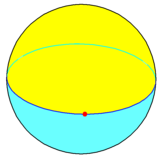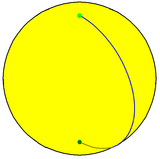Monogon: Difference between revisions
Appearance
Content deleted Content added
No edit summary Tag: Reverted |
m Reverted 1 edit by 2600:8805:D609:3800:3034:D116:97D7:767F (talk) to last revision by David Eppstein |
||
| Line 40: | Line 40: | ||
{{clear}} |
{{clear}} |
||
{{polygons}} |
{{polygons}} |
||
{{polyhedra}} |
|||
[[Category:Polygons by the number of sides]] |
[[Category:Polygons by the number of sides]] |
||
Revision as of 00:03, 16 August 2023
| Monogon | |
|---|---|
 On a circle, a monogon is a tessellation with a single vertex, and one 360-degree arc edge. | |
| Typ | Regular polygon |
| Edges and vertices | 1 |
| Schläfli symbol | {1} or h{2} |
| Coxeter–Dynkin diagrams | |
| Symmetry group | [ ], Cs |
| Dual polygon | Self-dual |
In geometry, a monogon, also known as a henagon, is a polygon with one edge and one vertex. It has Schläfli symbol {1}.[1]
In Euclidean geometry
In Euclidean geometry a monogon is a degenerate polygon because its endpoints must coincide, unlike any Euclidean line segment. Most definitions of a polygon in Euclidean geometry do not admit the monogon.
In spherical geometry
In spherical geometry, a monogon can be constructed as a vertex on a great circle (equator). This forms a dihedron, {1,2}, with two hemispherical monogonal faces which share one 360° edge and one vertex. Its dual, a hosohedron, {2,1} has two antipodal vertices at the poles, one 360° lune face, and one edge (meridian) between the two vertices.[1]
 Monogonal dihedron, {1,2} |
 Monogonal hosohedron, {2,1} |
See also
Look up monogon in Wiktionary, the free dictionary.
References
- Herbert Busemann, The geometry of geodesics. New York, Academic Press, 1955
- Coxeter, H.S.M; Regular Polytopes (third edition). Dover Publications Inc. ISBN 0-486-61480-8
